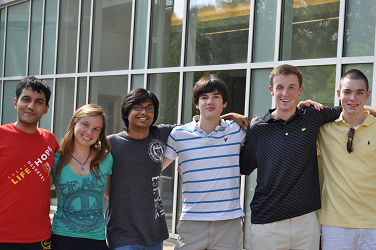Team:GeorgiaTech/Safety
From 2011.igem.org
Kgriswold3 (Talk | contribs) |
Kgriswold3 (Talk | contribs) |
||
| Line 1: | Line 1: | ||
|[[Image:GeorgiaTech_logo.jpg|200px|right|frame]] | |[[Image:GeorgiaTech_logo.jpg|200px|right|frame]] | ||
| - | |||
| - | |||
|[[Image:GeorgiaTech_team.png|right|frame|Your team picture]] | |[[Image:GeorgiaTech_team.png|right|frame|Your team picture]] | ||
| - | |||
| - | |||
| - | |||
| - | |||
<!--- The Mission, Experiments ---> | <!--- The Mission, Experiments ---> | ||
Revision as of 05:13, 2 August 2011
| |
| Home | Team | Official Team Profile | Project | Parts Submitted to the Registry | Modeling | Notebook | Safety | Attributions |
|---|
Safety
This page is dedicated to answering questions on the safety page.
1. Would any of your project ideas raise safety issues in terms of: researcher safety, public safety, or environmental safety?
The Georgia Tech iGEM project involves utilizing CRISPR systems to target antibiotic resistance in bacteria as a possible application for future human health. The bacteria that we are using is Streptococcus thermophilus, a common bacteria which is used for production of yogurt and other diary products. All bacteria strains used are non-pathogenic. Further, CRISPR system is naturally prevalent in 40% of the bacterial population and hence it is highly unlikely that the genes under experimentation would cause adverse effects. For proof of concept purposes, we will be using standard laboratory antibiotics: chloromphenicol kanamycin, and amplicillin. All laboratory materials, both biological and chemical, are safely used in a Biosafety Level 1 laboratory setting.
2. Do any of the new BioBrick parts (or devices) that you made this year raise any safety issues? If yes, Did you document these issues in the Registry? How did you manage to handle the safety issue? How could other teams learn from your experience?
The BioBrick device constructs contain an entire CRISPR system from S.thermophilus; none of these have known bio-safety issues.
3. Is there a local biosafety group, committee, or review board at your institution? If yes, what does your local biosafety group think about your project? If no, which specific biosafety rules or guidelines do you have to consider in your country?
The Occupational Health and Safety Committee and the Environmental Health and Safety Office of the Georgia Institute of Technology has approved Professor Eric Gaucher’s laboratory for Biosafety Level 1 Research.
4. Do you have any other ideas how to deal with safety issues that could be useful for future iGEM competitions? How could parts, devices and systems be made even safer through biosafety engineering?
Our group has discussed the sharp learning curve associated with having a young iGEM team with relatively little lab experience among them. All group members attended an institute biological laboratory safety class, but many things were learned along the way, specific to genetic engineering research. We would propose a collaboration of iGEM members to produce an online, visual, one-hour introductory course on the basic biosafety issues that could arise during the iGEM research process.
 "
"

